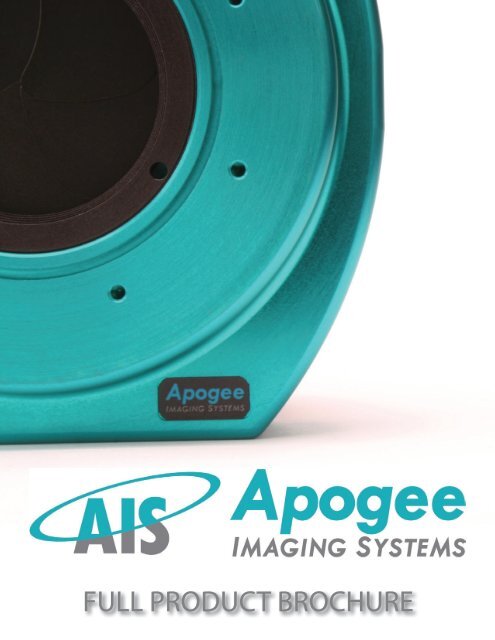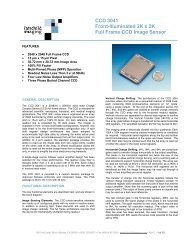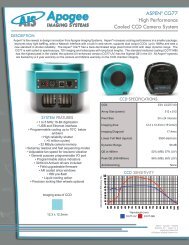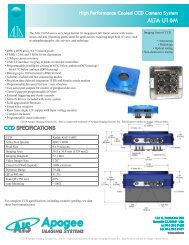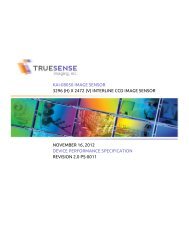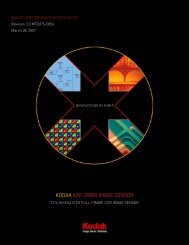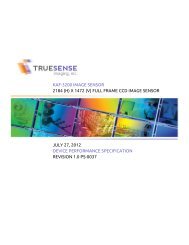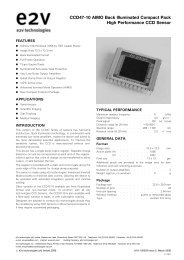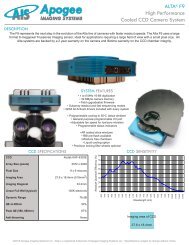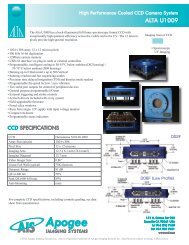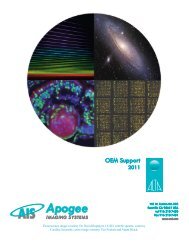Product Overview Brochure - Apogee Instruments, Inc.
Product Overview Brochure - Apogee Instruments, Inc.
Product Overview Brochure - Apogee Instruments, Inc.
Create successful ePaper yourself
Turn your PDF publications into a flip-book with our unique Google optimized e-Paper software.
FULL PRODUCT BROCHURE
ABOUT APOGEE<br />
APOGEE IMAGING SYSTEMS<br />
High Performance<br />
Cooled CCD Camera System<br />
Our Start<br />
In 1993, <strong>Apogee</strong> <strong>Instruments</strong>, <strong>Inc</strong>. was founded by Wayne Brown, in San Jose, California. Over the course of the next<br />
year <strong>Apogee</strong> developed, tested, and began selling its first line of CCD cameras, the AP ® series. In 1995, <strong>Apogee</strong>’s<br />
strength and determination was proved, as the company relocated to Arizona, in an effort to branch out into the scientific<br />
community. Partnering with the Naval Research Laboratory (NRL), in 1999, <strong>Apogee</strong>’s camera was launched on a<br />
sounding rocket as part of NRL’s VAULT (Very high Angular resolution Ultraviolet Telescope) project.<br />
Equipped with two new camera lines; KX ® and AM ® series, and camera accessories <strong>Apogee</strong> returned to Northern<br />
California in 2001.<br />
A Growing Reputation<br />
Already proven in the astronomy community, <strong>Apogee</strong> worked to expand its customer focus. <strong>Apogee</strong> cameras have<br />
become an integral part in many customers’ applications ranging from volcanology and spectroscopy to areas of medical<br />
research in various facilities spanning the globe. In 2010, <strong>Apogee</strong> <strong>Instruments</strong> announced a name change to <strong>Apogee</strong><br />
Imaging Systems. Although a small change to the name, it represented a significant step in the company’s growth in<br />
both products and customer breadth.<br />
COMMITMENT TO QUALITY<br />
Because you need reliable imaging systems to make your science happen, we strive to develop the best possible quality<br />
assurance system for all of our products, both incoming and outgoing. Through product consistency on incoming inventory<br />
and constant and consistent cross-checking during the build process, we are able to provide our customers with some<br />
of the best quality cameras currently on the market. At <strong>Apogee</strong> we are continually seeking to find ways to make our<br />
manufacturing processes faster and more efficient, while still maintaining the high level of quality our customers expect from<br />
us. Our knowledgeable engineering staff works side-by-side with the members of our production team to ensure that new<br />
products not only meet our customers needs, but are also faster and easier to assemble, so you get your camera on time.<br />
CORE VALUES<br />
Here at <strong>Apogee</strong> Imaging Systems, there are four keys values<br />
we focus on as a company:<br />
Strive for excellence.<br />
In our jobs and in our products, we want to produce our very<br />
best...every time.<br />
Practice honesty and integrity.<br />
These values are the core of our relationships both in house,<br />
with one another, and with our customers.<br />
Extraordinary Partnerships<br />
For two years <strong>Apogee</strong>’s engineering team worked intently with NASA’s Marshall Space Flight Center, to design a<br />
custom camera to fly aboard a Black Brant sounding rocket, as part of NASA’s High Resolution Coronal Imager, or Hi-C<br />
project. In 2012, NASA successfully launched the rocket carrying the <strong>Apogee</strong> camera to observe the solar corona and<br />
fundamental structures of the sun providing images with six times better resolution than ever before.<br />
<strong>Apogee</strong> Today<br />
With more than 20 years of experience, <strong>Apogee</strong> Imaging Systems continues to supply reliable, high performance cooled<br />
CCD cameras to many disciplines within the scientific community.<br />
Focus on the customer.<br />
We provide great customer service, both before and after<br />
the sale. We try our hardest to go the extra mile for every<br />
customer.<br />
Have fun at work.<br />
We are a growing yet small company...some call it an extended<br />
family. But first and foremost, we have all found a home at<br />
<strong>Apogee</strong> because we enjoy what we do!<br />
DIVERSITY<br />
From government and private research laboratories to worldclass<br />
professional observatories, our cameras are now used in<br />
more than 50 different countries. <strong>Apogee</strong> cameras have been<br />
used for a wide variety of applications, such as: spectroscopic<br />
analysis of water, soil and gems; detection of anthrax; analysis<br />
and detection of contaminants at nuclear reactors; imaging<br />
of fingerprints without chemicals; fluorescent imaging of cell<br />
tissues and microtitre plates; munitions testing; laser beam<br />
profiling; optics testing; and the discovery of astronomical<br />
objects.<br />
NGC 6853, The Dumbbell Nebula taken by R Jay GaBany with an<br />
<strong>Apogee</strong> Ascent ® A8050 using a Half-meter RCOS f/8<br />
CUSTOMER SUPPORT<br />
One of <strong>Apogee</strong>’s top priorities is our dedication to our<br />
customers. Whether it is assisting with CCD selection,<br />
helping you build your order , talking through customization<br />
options, helping you troubleshoot remotely or answering<br />
any questions you may have about your new camera,<br />
our customer and sales support staff is always on hand,<br />
eager to help with any of your needs or questions.<br />
Sales Support:<br />
sales@ccd.com<br />
Technical Support:<br />
support@ccd.com<br />
tel: (916) 218-7450 x 219<br />
hours: 9am to 5pm PST<br />
MADE IN THE USA<br />
<strong>Apogee</strong> is proud to boast that all it’s cameras are<br />
assembled and tested in our Northern California facility.<br />
Almost all of the mechanical parts involved in the<br />
manufacturing of <strong>Apogee</strong> cameras are produced in our<br />
own separate machining facility with three 3-axis CNC<br />
machines.<br />
©2013 <strong>Apogee</strong> Imaging<br />
Systems <strong>Inc</strong>. Aspen, Alta and<br />
Ascent are registered trademarks of<br />
<strong>Apogee</strong> Imaging Systems <strong>Inc</strong>.<br />
By expanding into broad markets with diverse demands,<br />
<strong>Apogee</strong> has had to develop a wide variety of technologies<br />
to fit our customers’ wide array of needs. Be it low noise<br />
and high sensitivity coupled with high quantitative accuracy<br />
or speed and ease of use, there is one thing all our customers<br />
need: high performance at lower prices. At <strong>Apogee</strong>, we work<br />
our hardest to meet all your demands.<br />
Image by <strong>Apogee</strong> personnel<br />
COMPANY INFORMATION
OUR CAMERAS<br />
PRODUCT INFORMATION<br />
High Performance<br />
Cooled CCD Camera System<br />
<strong>Apogee</strong> currently manufactures three camera lines: Alta ® F Series, Ascent ® and now introducing Aspen ® . Each product<br />
line supports a wide variety of CCD sensors. Below is a chart comparing the vital system features of each camera type<br />
to better help you determine which product will best suit your needs. Our sales staff is always on hand to assist with<br />
any questions you may have or to help you select which camera would best suit your individual needs or the needs of<br />
your company.<br />
Ascent ® Alta ® Aspen ®<br />
Digitization 16 bit, programmable speed Fast 12 bit and slower 16 bit 16 bit, programmable speed<br />
Maximum throughput Up to 16 Mpixels/sec Up to 7 Mpixels/sec Up to 16 Mpixels/sec<br />
Dual channel readout Standard on most Interline CCDs N/A Standard on most Interline CCDs<br />
Progressive scan for<br />
interlines<br />
Standard Standard Standard<br />
Video focus mode Standard N/A N/A<br />
Maximum cooling up to 40ºC below ambient up to 55ºC below ambient up to 70ºC below ambient<br />
Temperature regulation ± 0.1 ºC ± 0.1 ºC ± 0.1 ºC<br />
Programmable gain and<br />
offset<br />
Standard N/A High speed mode only<br />
USB2 interface Standard Standard Standard<br />
Ethernet N/A N/A 2 Mpixels/sec<br />
Electromechanical<br />
shutter<br />
Programmable fan<br />
speed<br />
Field upgradeable<br />
firmware<br />
N/A Standard on FF, opt on Interline Standard on FF, opt on Interline<br />
N/A Standard Standard<br />
Standard Standard Standard<br />
Chamber window Fused silica Fused silica Fused silica<br />
Peripheral<br />
communications<br />
General purpose I/O<br />
port<br />
8 pin mini-DIN connector 8 pin mini-DIN connector 8 pin mini-DIN connector<br />
Standard Standard Standard<br />
Programmable LEDs Standard Standard Standard<br />
Power input 6V 12V 12V<br />
Internal memory 32 Mbytes 32 Mbytes 32 Mbytes<br />
CCDs supported Interline only Full frame, Interline, Spectroscopy Full frame, Interline, Spectroscopy<br />
External triggering Standard Standard Standard<br />
Image sequences up to 65535 images up to 65535 images up to 65535 images<br />
Hardware binning up to 8 x height of CCD up to 8 x height of CCD up to 8 x height of CCD<br />
Subarray readout Standard Standard Standard<br />
TDI readout & Kinetics<br />
mode<br />
N/A Standard on Full Frame TDI only<br />
Back focal distance 0.32” (8.1 mm) 0.69” (17.5 mm) and up 0.69” (17.5 mm) and up<br />
C-mount interface Optional, external Standard for D01 & D03 housings Standard for G01<br />
Housing size (small) 4.8” x 3.25” x 3.25” 6” x 6” x 2.1” to 2.7” 6.5” x 6.4” x 3.8” to 4.3”<br />
Housing size (large) N/A 7” x 7” x 2.7” to 4.1” 6.5” x 6.4” x 4.7”<br />
Warranty (parts & labor) 2 years 2 years 2 years<br />
Warranty against<br />
condensation<br />
Lifetime Lifetime Lifetime<br />
©2013 <strong>Apogee</strong> Imaging<br />
Systems <strong>Inc</strong>. Aspen, Alta and<br />
Ascent are registered trademarks of<br />
<strong>Apogee</strong> Imaging Systems <strong>Inc</strong>.<br />
TWO-YEAR WARRANTY<br />
All <strong>Apogee</strong> cameras are backed with a twoyear<br />
warranty on the camera and a lifetime<br />
warranty on the CCD chamber integrity.<br />
Warranty extensions are available for an<br />
additional fee.<br />
INTERNAL MEMORY<br />
Each <strong>Apogee</strong> system is equipped with<br />
32Mbytes of SDRAM image memory. This<br />
localized memory is important for two<br />
reasons: firstly, to buffer the image transfer,<br />
protecting it from any noise-producing<br />
interruptions that may incur during the<br />
process. Secondly, it allows for faster<br />
digitization of image sequences, up to the<br />
limit of the internal memory of the camera.<br />
FIELD UPGRADEABLE FIRMWARE<br />
Every camera arrives coded with<br />
information that identifies the type of system<br />
you have received, it’s configuration, the<br />
CCD used in it and the revision number of<br />
the active firmware. For an added level of<br />
convenience, the most current drivers and<br />
firmware updates are always available<br />
for download on our website (Support ><br />
Drivers & Downloads), allowing cameras<br />
to be updated at any time, from anywhere<br />
and making it easier for <strong>Apogee</strong> Customer<br />
Support staff to troubleshoot remotely when<br />
necessary.<br />
LIQUID COOLING<br />
<strong>Apogee</strong> offers a liquid cooling option on both<br />
the Alta ® and Aspen ® systems. By putting<br />
a liquid recirculation plate in place of the<br />
fans, the chiller unit is about to remove heat<br />
from the camera body to reduce warm air<br />
disturbance around the camera. In some<br />
cases additional cooling may be gained,<br />
but the camera housing must not be cooled<br />
below the dew point.<br />
Aspen G01 Liquid Recirculation camera<br />
Our general purpose I/O<br />
port can be used for a wide<br />
variety of external trigger<br />
inputs, including line-by-line<br />
control of TDI shifts.<br />
EXTERNAL TRIGGERING<br />
External hardware triggers can<br />
be utilized through a general I/O<br />
port available on every <strong>Apogee</strong><br />
system. External triggers can be<br />
coupled with software triggers and<br />
used in a variety of ways to trigger<br />
image sequences. A software<br />
or hardware trigger can be used<br />
to initiate a single exposure or a<br />
sequence of exposures for a set<br />
duration and delay between each<br />
exposure. A software trigger may<br />
also be used to start a sequence<br />
with the external trigger used to<br />
trigger each subsequent image.<br />
The external trigger can also be<br />
used to trigger row shifts for timedelayed<br />
integration or it can be<br />
used to trigger block shifts for<br />
kinetic imaging.<br />
PROGRESSIVE SCAN<br />
Interline transfer CCDs go through<br />
a process in which they first shift<br />
charge from the photodiode in<br />
each pixel to the masked storage<br />
diode, then march the charge<br />
through the storage diodes to the<br />
serial register. Acquisition of a new<br />
image in the photodiodes during<br />
readout of the previous image<br />
is called “progressive scan” or<br />
continuous imaging. This feature is<br />
available on every interline transfer<br />
supported camera.<br />
PROGRAMMABLE FANS<br />
Due to customer demand, in both<br />
the Alta ® and Aspen ® camera series<br />
the fans may be turned completely<br />
off or run at a much slower speed to<br />
maintain adequate cooling with no<br />
vibration. For applications where<br />
vibration is not as big of a concern,<br />
the fan speed may be maximized<br />
for greatest cooling.<br />
PROGRAMMABLE LEDS<br />
There are two LEDs visible through<br />
each camera faceplate to show status<br />
of a variety of the camera’s functions,<br />
such as the camera has reached the<br />
set temperature, the shutter is open or<br />
the camera is waiting for an external<br />
trigger. And if stray light is a concern,<br />
the LEDs can be turned off.<br />
HARDWARE BINNING<br />
All <strong>Apogee</strong> cameras support hardware<br />
binning up to 8 in the horizontal direction<br />
and up to the height of the CCD in the<br />
vertical direction. Binning can be used<br />
to increase frame rate, dynamic range<br />
or apparent sensitivity by collecting<br />
more light into a superpixel. For more<br />
information about the benefits of pixel<br />
binning, visit the CCD University on our<br />
website.<br />
PRODUCT INFORMATION
DESCRIPTION<br />
ASPEN ®<br />
High Performance<br />
Cooled CCD Camera System<br />
Aspen ® is the newest in design innovation from <strong>Apogee</strong> Imaging Systems. Aspen ® increases cooling performance in a<br />
smaller package, improves stray light baffling, adds a Network interface with a built-in web server, supports dual output<br />
CCDs up to 16Mhz and sets a new standard in shutter reliability. All Aspen ® systems are backed by a 2 year warranty<br />
on the camera and lifetime warranty on the CCD chamber integrity.<br />
PC Interface<br />
SYSTEM SPECIFICATIONS<br />
USB 2.0 to 16MHz; Network interface<br />
with built-in web server, up to 2MHz<br />
throughput<br />
G01 - STANDARD FOR SMALL CCDS<br />
G07 - STANDARD FOR LARGE CCDS<br />
1” Aperture<br />
C-Mount<br />
1-32 UN-2B<br />
.68” Flange Focal Distance<br />
(optical)<br />
35mm shutter on Full Frame<br />
CCDs<br />
No shutter on Interline CCDs<br />
Liquid Recirculation Available<br />
Max. Cable Length<br />
USB: 5 meters between hubs; 5 hubs<br />
maximum (max. total of 30m)<br />
Ethernet: 100 meters maximum<br />
2.25” Aperture<br />
3” Thread Option<br />
Optional Thread-in Fieldstop<br />
Digital Resolution<br />
System Noise (typical)<br />
16 bits, single or dual channel<br />
7 e - RMS at 1 MHz<br />
1.01” Flange Focal Distance<br />
(optical)<br />
SYSTEM FEATURES<br />
• 1 to 16 MHz 16-Bit digitization<br />
• USB and Ethernet interface<br />
• Programmable cooling up to 70°C below ambient<br />
• High reliability shutter (>5 million cycles)<br />
Pixel Binning<br />
Exposure Time<br />
Image Sequencing<br />
Frame Sizes<br />
1 x 1 to 8 x height of CCD<br />
Interline CCDs:<br />
100 microseconds to 183 minutes<br />
Full Frame & Spectroscopy CCDs:<br />
100 milliseconds to 183 minutes<br />
(2.56 microsecond increments)<br />
1 to 65535 image sequences under<br />
software control<br />
Full frame, subframe, focus mode<br />
G06 - OPTIONAL LOW PROFILE<br />
58mm shutter on Full Frame and<br />
Spectroscopy CCDs<br />
No shutter on Interline CCDs<br />
Liquid Recirculation Available<br />
2.25” Aperture<br />
• 32 MByte camera memory<br />
• Subarray readout and fast sequencing modes<br />
• Adjustable fan speed for low/zero vibration<br />
• General purpose programmable I/O port<br />
• Programmable status indicators<br />
• Dual channel CCD support<br />
• 32/64 bit ActiveX drivers included with every system<br />
• Field upgradeable firmware<br />
Cooling (typical)<br />
Dark Current (typical<br />
for interline and frontilluminated<br />
CCDs)<br />
Temperature Stability<br />
Thermoelectric cooler with forced air.<br />
Maximum cooling up to 70°C below<br />
ambient temperature.<br />
0.01 e - /pixel/sec (-30°C)<br />
+/- 0.1 o C<br />
.55” Flange Focal Distance<br />
(optical)<br />
No shutter<br />
Liquid Recirculation Available<br />
• AR coated silica windows<br />
• RBI pre-flash on non-Interline CCDs<br />
•Moisture free chambers<br />
• Liquid cooling options<br />
• Precision locking filter wheels optional<br />
Operating Environment<br />
Power<br />
-25º to 40ºC. Relative humidity: 10 to<br />
90% non-condensing.<br />
50W maximum power with cooling<br />
maximum. AC/DC “brick” supply with<br />
int’l AC input plug (100-240V, 50-60Hz).<br />
Alternate 12V input from user’s source.<br />
G09 - HIGHEST COOLING OPTION<br />
2.25” Aperture<br />
3” Thread Option<br />
Optional Thread-in Fieldstop<br />
Remote Triggering<br />
Op. System Support<br />
Featured Accessories<br />
LVTTL input allows exposure to start<br />
within 25 microseconds of rising edge<br />
of trigger.<br />
Windows, Macintosh, Linux<br />
AFW50-7S Filter Wheel, AFW50-9R<br />
Filter Wheel, AFW50-10S Filter Wheel<br />
and AFW31-17R Filter Wheel<br />
1.36” Flange Focal Distance<br />
(optical)<br />
58mm shutter on Full Frame and<br />
Spectroscopy CCDs<br />
No shutter on Interline CCDs<br />
Liquid Recirculation Available<br />
©2013 <strong>Apogee</strong> Imaging<br />
Systems <strong>Inc</strong>. Aspen, Alta and<br />
Ascent are registered trademarks of<br />
<strong>Apogee</strong> Imaging Systems <strong>Inc</strong>.<br />
151 N. Sunrise Ave. Ste 902<br />
Roseville CA 95661 USA<br />
www.ccd.com<br />
tel 916 218 7450<br />
fax 916 218 7451<br />
ASPEN®
ASPEN ® - G07 CONFIGURATION<br />
ASPEN ®<br />
High Performance<br />
Cooled CCD Camera System<br />
FULL FRAME CCDS<br />
Model CCD Array Size<br />
INTERLINE TRANSFER CCDS<br />
Pixel Size<br />
(microns)<br />
Array size (mm)<br />
X<br />
Y<br />
Imaging Area<br />
(mm2)<br />
Diagonal<br />
(mm)<br />
CG1 KAF-0402ME 768 512 9 6.9 4.6 31.9 8.3 M<br />
CG2 KAF-1603ME 1536 1024 9 13.8 9.2 127.4 16.6 M<br />
CG6 KAF-1001E 1024 1024 24 24.6 24.6 604 34.8 M<br />
CG9 KAF-6303E 3072 2048 9 27.6 18.4 509.6 33.2 M<br />
CG32 KAF-3200 2184 1472 6.8 14.9 10 148.7 17.9 M<br />
CG47 E2V CCD47-10** 1024 1024 13 13.3 13.3 177 18.8 M<br />
CG77 E2V CCD77-00** 512 512 24 12.3 12.3 151 17.4 M<br />
CG260 KAF-261E 512 512 20 10.2 10.2 104.9 14.5 M<br />
Mono=M<br />
Color=C<br />
CG8300 KAF-8300CE 3448 2574 5.4 18.6 13.9 259 23.2 M, C<br />
CG3041 Fairchild 3041 2048 2048 15 30.7 30.7 944 43.4 M<br />
CG42 E2V CCD42-40** 2048 2048 13.5 27.6 27.6 764 39.1 M<br />
CG230 E2VCCD230-42** 2048 2048 15 30.7 30.7 944 43.4 M<br />
CG9000 KAF-9000 3058 3058 12 36.7 36.7 1346.6 51.9 M<br />
CG16 KAF-16801E 4096 4096 9 36.9 36.9 1359 52.1 M<br />
CG16M KAF-16803 4096 4096 9 36.9 36.9 1359 52.1 M<br />
Model CCD Array Size<br />
Pixel Size<br />
(microns)<br />
Array size (mm)<br />
X<br />
Y<br />
Imaging Area<br />
(mm2)<br />
Diagonal<br />
(mm)<br />
Mono=M<br />
Color=C<br />
CG285 ICX285AL 1360 1024 6.45 8.8 6.6 57.9 11 M, C<br />
CG1050 KAI-1050 1024 1024 5.5 5.6 5.6 34.8 8.3 M, C<br />
CG2000 KAI-2020 1600 1200 7.4 11.8 8.9 105.1 14.8 M, C<br />
CG2050 KAI-2050 1600 1200 5.5 8.8 6.6 58.1 11 M, C<br />
CG2150 KAI-2150 1920 1080 5.5 10.6 5.9 62.7 12.1 M, C<br />
CG4000 KAI-4022 2048 2048 7.4 15.2 15.2 229.7 21.4 M, C<br />
CG4050 KAI-4050 2336 1752 5.5 12.8 9.6 123.8 16.1 M, C<br />
CG8050 KAI-8050 3298 2472 5.5 18.1 13.6 246.5 22.7 M, C<br />
CG16000 KAI-16000 4872 3248 7.4 36 24 866.5 43.3 M, C<br />
CG16050 KAI-16050 4896 3264 5.5 26.9 17.95 478 32.4 M, C<br />
CG29050 KAI-29050 6576 4384 5.5 36 24 872 43.5 M, C<br />
SPECTROSCOPY CCDS<br />
Model CCD Array Size<br />
Pixel Size<br />
(microns)<br />
Array size (mm)<br />
X<br />
Y<br />
Imaging Area<br />
(mm2)<br />
Diagonal<br />
(mm)<br />
Mono=M<br />
Color=C<br />
CG30 E2V CCD30-11** 1024 256 26 26.6 6.7 177 27.4 M<br />
CG30-OE E2V CCD30-11** 1024 256 26 26.6 6.7 177 27.4 M<br />
CG1007<br />
CG1008<br />
CG1009<br />
CG1107<br />
CG1108<br />
CG1109<br />
Hamamatsu S10140-<br />
1007**<br />
Hamamatsu S10140-<br />
1008**<br />
Hamamatsu S10140-<br />
1009**<br />
Hamamatsu S10140-<br />
1107**<br />
Hamamatsu S10140-<br />
1108**<br />
Hamamatsu S10140-<br />
1109**<br />
1024 122 12 12.3 1.5 18 12.4 M<br />
1024 250 12 12.3 3 36.9 12.6 M<br />
1024 506 12 12.3 6.1 74.6 13.7 M<br />
512 122 12 24.6 1.5 36 24.6 M<br />
1024 250 12 24.6 3 73.7 24.8 M<br />
2048 506 12 24.6 6.1 149.2 25.3 M<br />
©2013 <strong>Apogee</strong> Imaging<br />
Systems <strong>Inc</strong>. Aspen, Alta and<br />
Ascent are registered trademarks of<br />
<strong>Apogee</strong> Imaging Systems <strong>Inc</strong>.<br />
151 N. Sunrise Ave. Ste 902<br />
Roseville CA 95661 USA<br />
www.ccd.com<br />
tel 916 218 7450<br />
fax 916 218 7451<br />
ASPEN®
DESCRIPTION<br />
ALTA ® F SERIES<br />
High Performance<br />
Cooled CCD Camera System<br />
The Alta ® F Series represents the next step in the evolution of the Alta ® line of cameras with faster readout speeds. The<br />
Alta ® line continues to support a wide variety of front-illuminated, back-illuminated and interline transfer CCDs. All Alta ®<br />
systems are backed by a 2 year warranty on the camera and lifetime warranty on the CCD chamber integrity. Current U<br />
Series customers can easily upgrade their systems to F Series, for more information contact <strong>Apogee</strong> Customer Support.<br />
D01/D05 - STANDARD FOR SMALL CCDS<br />
Standard: D01<br />
Low Profile: D05<br />
PC Interface<br />
Max. Cable Length<br />
SYSTEM SPECIFICATIONS<br />
USB 2.0<br />
5 meters between hubs, 5 hubs<br />
max. (max. total of 30m); or up to 50m<br />
with icron 2.0 Ranger extender<br />
D02/D06 - STANDARD FOR MIDSIZE CCDS<br />
Standard: D02<br />
Low Profile: D06<br />
Digital Resolution<br />
16 bits to 8 MHz<br />
SYSTEM FEATURES<br />
• 1 to 8 MHz 16-Bit digitization<br />
• 32 MByte camera memory<br />
• Field upgradeable firmware<br />
• Subarray readout and fast sequencing modes<br />
• 32/64 bit ActiveX drivers included with every system<br />
• Programmable cooling to 55 o C below ambient<br />
• General purpose programmable I/O port<br />
• Adjustable fan speed for low/zero vibration<br />
• Programmable status indicators<br />
System Noise (typical)<br />
Pixel Binning<br />
Exposure Time<br />
Image Sequencing<br />
Frame Sizes<br />
7 to 9 e - RMS at 1 MHz<br />
1 x 1 to 8 x height of CCD<br />
Interline CCDs:<br />
1 millisecond to 183 minutes<br />
Front- and Back-Illuminated CCDs:<br />
20 milliseconds to 183 minutes<br />
(2.56 microsecond increments)<br />
1 to 65535 image sequences under<br />
software control<br />
Full frame, subframe, focus mode<br />
D07/D11 - STANDARD FOR LARGE CCDS<br />
Standard: D07<br />
Low Profile: D11<br />
• AR coated silica windows<br />
• RBI pre-flash available<br />
• Moisture free chambers<br />
• Liquid cooling option<br />
• Precision locking filter wheels optional<br />
Cooling (typical)<br />
Dark Current (typical<br />
for interline and frontilluminated<br />
CCDs)<br />
Thermoelectric cooler with forced air.<br />
Maximum cooling up to 55°C below<br />
ambient temperature.<br />
0.01 e - /pixel/sec (-30°C)<br />
Temperature Stability<br />
+/- 0.1 o C<br />
Operating Environment<br />
Power<br />
-25º to 40ºC. Relative humidity: 10 to<br />
90% non-condensing.<br />
40W maximum power with shutter open<br />
and cooling maximum. AC/DC “brick”<br />
supply with int’l AC input plug (100-<br />
240V, 50-60Hz). Alternate 12V input<br />
from user’s source.<br />
Power<br />
USB<br />
Status<br />
LEDs<br />
I/O Connector<br />
Remote Triggering<br />
LVTTL input allows exposure to start<br />
within 25 microseconds of rising edge<br />
of trigger.<br />
Op. System Support<br />
Windows, Macintosh, Linux<br />
Featured Accessories<br />
AFW50-7S Filter Wheel, AFW50-9R<br />
Filter Wheel, AFW50-10S Filter Wheel<br />
and AFW31-17R Filter Wheel<br />
©2013 <strong>Apogee</strong> Imaging<br />
Systems <strong>Inc</strong>. Aspen, Alta and<br />
Ascent are registered trademarks of<br />
<strong>Apogee</strong> Imaging Systems <strong>Inc</strong>.<br />
151 N. Sunrise Ave. Ste 902<br />
Roseville CA 95661 USA<br />
www.ccd.com<br />
tel 916 218 7450<br />
fax 916 218 7451<br />
ALTA® F SERIES
ALTA ® F SERIES - D07 CONFIGURATION<br />
ALTA ® F SERIES<br />
High Performance<br />
Cooled CCD Camera System<br />
BACK-ILLUMINATED CCDS<br />
Camera<br />
Model<br />
CCD<br />
FRONT-ILLUMINATED CCDS<br />
Array Size<br />
Pixel Size<br />
(microns)<br />
Array size (mm)<br />
Imaging Area<br />
(mm2)<br />
F42 E2V CCD42-40 2048 2048 13.5 27.6 27.6 764 39.1<br />
F230 E2V CCD230-42 2048 2048 15 30.7 30.7 944 43.4<br />
F47 E2V CCD47-10 1024 1024 13 13.3 13.3 177 18.8<br />
F77 E2V CCD77-00 512 512 24 12.3 12.3 151 17.4<br />
F30 E2V CCD30-11 1024 256 26 26.6 6.7 177 27.4<br />
F1109<br />
F1108<br />
F1107<br />
F1009<br />
F1008<br />
F1007<br />
Hamamatsu S10140-<br />
1109<br />
Hamamatsu S10140-<br />
1108<br />
Hamamatsu S10140-<br />
1107<br />
Hamamatsu S10140-<br />
1009<br />
Hamamatsu S10140-<br />
1008<br />
Hamamatsu S10140-<br />
1007<br />
X<br />
Y<br />
Diagonal<br />
(mm)<br />
2048 506 12 24.6 6.1 149.2 25.3<br />
1024 250 12 24.6 3.0 73.7 24.8<br />
512 122 12 24.6 1.5 36.0 24.6<br />
1024 506 12 12.3 6.1 74.6 13.7<br />
1024 250 12 12.3 3.0 36.9 12.6<br />
1024 122 12 12.3 1.5 18.0 12.4<br />
Camera<br />
Model<br />
CCD<br />
Array Size<br />
Pixel Size<br />
(microns)<br />
Array size (mm)<br />
X<br />
Y<br />
Imaging Area<br />
(mm2)<br />
Diagonal<br />
(mm)<br />
Mono=M<br />
Color=C<br />
F16 KAF-16801E 4096 4096 9 36.9 36.9 1359.0 52.1 M<br />
F16M KAF-16803 4096 4096 9 36.9 36.9 1359.0 52.1 M<br />
F9000 KAF-09000 3058 3058 12 36.7 36.7 1346.6 51.9 M<br />
F8300 KAF-8300CE 3448 2574 5.4 18.6 13.9 259 23.2 M,C<br />
F9 KAF-6303E 3072 2048 9 27.6 18.4 509.6 33.2 M<br />
F4320 KAF-4320E 2048 2048 24 49.1 49.1 2415 69.5 M<br />
F43 KAF-4301 2048 2048 24 49.1 49.1 2415 69.5 M<br />
F3041 Fairchild 3041 2048 2048 15 30.7 30.7 944 43.4 M<br />
F32 KAF-3200 2184 1472 6.8 14.9 10.0 148.7 17.9 M<br />
F2 KAF-1603ME 1536 1024 9 13.8 9.2 127.4 16.6 M<br />
F6 KAF-1001E 1024 1024 24 24.6 24.6 604.0 34.8 M<br />
F1 KAF-0402ME 768 512 9 6.9 4.6 31.9 8.3 M<br />
F260 KAF-0261E 512 512 20 10.2 10.2 104.9 14.5 M<br />
F30-OE E2V CCD30-11 1024 256 26 26.6 6.7 177 27.4 M<br />
F50 KAF-50100 8176 6132 6 49.1 36.8 1087 61.3 M,C<br />
INTERLINE TRANSFER CCDS<br />
Camera<br />
Model<br />
Kodak CCD<br />
Array Size<br />
Pixel Size<br />
(microns)<br />
Array size (mm)<br />
X<br />
Y<br />
Imaging Area<br />
(mm2)<br />
Diagonal<br />
(mm)<br />
F29050 KAI-29050 6576 4384 5.5 36 24 872 43.5 M,C<br />
F16000 KAI-16000 4872 3248 7.4 36 24 866.5 43.3 M,C<br />
F4000 KAI-4022 2048 2048 7.4 15.2 15.2 229.7 21.4 M,C<br />
F2000 KAI-2020 1600 1200 7.4 11.8 8.9 105.1 14.8 M,C<br />
Mono=M<br />
Color=C<br />
©2013 <strong>Apogee</strong> Imaging<br />
Systems <strong>Inc</strong>. Aspen, Alta and<br />
Ascent are registered trademarks of<br />
<strong>Apogee</strong> Imaging Systems <strong>Inc</strong>.<br />
151 N. Sunrise Ave. Ste 902<br />
Roseville CA 95661 USA<br />
www.ccd.com<br />
tel 916 218 7450<br />
fax 916 218 7451<br />
ALTA® F SERIES
DESCRIPTION<br />
ASCENT ®<br />
High Performance<br />
Cooled CCD Camera System<br />
The Ascent ® Camera Series supports a variety of interline transfer sensors with high quantum efficiency and low dark<br />
current. Most cameras are available with a choice of monochrome sensor or color sensor with a Bayer mosaic. Low<br />
noise and small pixels are ideal for OEM applications, astrophotography, biological sciences, guiding / adaptive optics,<br />
and other high frame rate applications.<br />
CCD CONFIGURATIONS<br />
Camera<br />
Model<br />
CCD Array Pixels<br />
Pixel size<br />
(microns)<br />
CCD Size<br />
(mm)<br />
Area<br />
(mm2)<br />
A29050 KAI-29050 6576 x 4384 28.8M 5.5 36 x 24 872 43.5<br />
A16050 KAI-16050 4896 x 3264 15.98M 5.5 26.9 x 17.95 478 32.4<br />
A16000 KAI-16000 4872 x 3248 15.8M 7.4 36 x 24 866.5 43.3<br />
A8050 KAI-8050 3296 x 2472 8.1M 5.5 18.1 x 13.6 246.5 22.7<br />
A4050 KAI-4050 2336 x 1752 4.2M 5.5 12.8 x 9.6 123.8 16.1<br />
Diagonal<br />
(mm)<br />
PC Interface<br />
SYSTEM SPECIFICATIONS<br />
USB 2.0<br />
A4000 KAI-4022 2048 x 2048 4.2M 7.4 15.2 x 15.2 229.7 21.4<br />
A2150 KAI-2150 1920 x 1080 2.1M 5.5 10.6 x 5.9 62.7 12.1<br />
A2050 KAI-2050 1600 x 1200 1.9M 5.5 8.8 x 6.6 58.1 11.0<br />
A2000 KAI-2020 1600 x 1200 1.9M 7.4 11.8 x 8.9 105.1 14.8<br />
Max. Cable Length<br />
5 meters between hubs, 5 hubs<br />
max. (max. total of 30m); or up to 50m<br />
with icron 2.0 Ranger extender<br />
A1050 KAI-1050 1024 x 1024 1.1M 5.5 5.6 x 5.6 34.8 8.3<br />
A694 ICX694 2750 x 2200 6.1M 4.52 12.5 x 9.99 123.6 15.99<br />
A340 KAI-0340 684 x 484 313K 7.4 4.8 x 3.6 17.2 6.0<br />
SYSTEM FEATURES<br />
• 1 to 16 MHz 16-Bit digitization<br />
• Field upgradeable firmware<br />
• Subarray readout and fast sequencing modes<br />
• 32/64 bit ActiveX drivers included with every system<br />
Digital Resolution<br />
System Noise (typical)<br />
Pixel Binning<br />
Exposure Time<br />
16 bits (single channel): 3.3 and<br />
10Mpixels/sec; 8 MHz (dual channel):<br />
16Mpixels/sec<br />
4.5 e - RMS at 3.3 MHz (A285); 6 e -<br />
RMS at 10 MHz (A285)*; 7 e - RMS at<br />
8/16 MHz (A2150)<br />
1 x 1 to 8 x height of CCD<br />
100 microseconds to 183 minutes<br />
(2.56 microsecond increments)<br />
A285 ICX285 1360 x 1024 1.4M 6.45 8.8 x 6.6 57.9 11.0<br />
A205 ICX205 1360 x 1024 1.4M 4.65 6.3 x 4.8 30.1 7.9<br />
MECHANICAL SPECIFICATIONS<br />
• Programmable cooling to 35 o C below ambient<br />
• External triggering and strobe controls<br />
• Programmable offset and gain<br />
• Programmable status indicators<br />
Image Sequencing<br />
Frame Sizes<br />
1 to 65535 image sequences under<br />
software control<br />
Full frame, subframe, focus mode<br />
• CCDs up to 29 Megapixels<br />
• Dual channel CCD support<br />
• Moisture free chambers<br />
• Video focus mode<br />
• Precision locking filter wheels optional<br />
Cooling (typical)<br />
Dark Current (typical)<br />
Temperature Stability<br />
Thermoelectric cooler with forced air.<br />
Maximum cooling up to 30-35°C below<br />
ambient temperature.<br />
A205: 0.1 e - /pixel/sec (-15 o C)<br />
+/- 0.1 o C<br />
Operating Environment<br />
-25º to 40ºC. Relative humidity: 10 to<br />
90% non-condensing.<br />
Power<br />
20W maximum power with cooling<br />
maximum. AC/DC “brick” supply with<br />
int’l AC input plug (100-240V, 50-60Hz).<br />
Alternate 6V input from user’s source.<br />
Remote Triggering<br />
LVTTL input allows exposure to start<br />
within 25 microseconds of rising edge<br />
of trigger.<br />
Back Focal Distance<br />
Standard: 0.32” (0.81cm). [optical]<br />
Mounting<br />
1.5” x 2.5” bolt pattern, 6-32 thread.<br />
Optional C-mount (1” 32 tpi thread),<br />
Nikon F-mount, or 2” slip-fit adapters.<br />
Op. System Support<br />
Windows, Macintosh, Linux<br />
Featured Accessories<br />
CFW25-6R Filter Wheel, CFW31-8R<br />
Filter Wheel, AFW50-7S Filter Wheel<br />
and AFW50-9R Filter Wheel<br />
©2013 <strong>Apogee</strong> Imaging Systems <strong>Inc</strong>. Aspen, Alta and Ascent are registered trademarks of <strong>Apogee</strong> Imaging Systems <strong>Inc</strong>.<br />
151 N. Sunrise Ave. Ste 902<br />
Roseville CA 95661 USA<br />
www.ccd.com<br />
tel 916 218 7450<br />
fax 916 218 7451<br />
ASCENT®
APOGEE ACCESSORIES<br />
COMPACT FILTER WHEELS<br />
The compact filter wheels, or CFW, designed for use with the<br />
Ascent ® series, support two sizes of filters. The CFW25-6R<br />
holds up to six 25mm or 1” round filters and the CFW31-8R<br />
holds up to eight 31mm or 1.25” round filters. These filter<br />
wheels are made to be directly integrated with the Ascent ®<br />
cameras via a peripheral interface accessible on the front of<br />
each system. The filter wheels are also capable of coupling<br />
with a variety of lens and slip fit adapters.<br />
ACCESSORIES<br />
High Performance<br />
Cooled CCD Camera System<br />
<strong>Apogee</strong> Imaging Systems offers a full line of accessories including precision locking filter wheels that support up to four<br />
different filter sizes, a wide selection of filters, general and custom face plate and lens adapters, cable extenders and<br />
various software options.<br />
CFW25-6R & CFW31-8R<br />
6 positions / 8 positions<br />
25mm or 1” round / 31mm or 1.25” round filters<br />
2 to 5mm thick filters<br />
Drop-in (both), threaded (8R only)<br />
Weighs 0.85lbs. (0.39kg) / 1.85lbs. (0.84kg)<br />
0.775” (19.7mm) / 0.925” (23.5mm) in height<br />
DOUBLE FILTER WHEELS<br />
<strong>Apogee</strong> has now made it possible to attach any two of the<br />
same Alta ® filter wheels together, back-to-back, with no<br />
gap. It can be utilized with the AFW50-7S, AFW50-9R,<br />
AFW50-10S and AFW31-17R.<br />
ALTA ® FILTER WHEELS<br />
Alta ® filter wheels, or AFW, are actually compatible with every<br />
<strong>Apogee</strong> camera line, not just Alta ® . The AFW comes in four<br />
different configurations: AFW50-7S, AFW50-9R, AFW50-10S<br />
and now introducing the AFW31-17R.<br />
AFW50-7S<br />
7 positions<br />
50mm or 2” square filters<br />
2 to 7mm thick filters<br />
Drop-in<br />
Weighs 3.5lbs. (1.6kg)<br />
1.15” (29.2mm) in height<br />
AFW50-9R<br />
9 positions<br />
50mm or 2” round filters<br />
2 to 7mm thick filters<br />
Drop-in<br />
Weighs 3.5lbs. (1.6kg)<br />
1.15” (29.2mm) in height<br />
AFW31-17R<br />
17 positions<br />
31mm or 1.25” round filters<br />
2 to 7mm thick filters<br />
Drop-in<br />
Weighs 5.0lbs. (2.3kg)<br />
1.15” (29.2mm) in height<br />
AFW50-10S<br />
10 positions<br />
50mm or 2” square filters<br />
2 to 7mm thick filters<br />
Drop-in<br />
Weighs 5.0lbs. (2.3kg)<br />
1.15” (29.2mm) in height<br />
FILTERS<br />
<strong>Apogee</strong> carries all major brands<br />
and types of filters; from single<br />
notch to multi notch, short pass to<br />
long pass, Chroma ® to Astrodon ®<br />
and everything in between. We<br />
even provide custom sizing and<br />
coating options upon request in<br />
order to support all industry of<br />
filters your project demands.<br />
FACE PLATE ADAPTERS<br />
LR001 - LIQUID CHILLER UNIT<br />
The LR001 Liquid Chiller<br />
Unit provides precise<br />
control of the temperature of<br />
recirculated liquid for optimal<br />
Flange adapters allow you<br />
to attach anything from an<br />
SLR camera lens to a large<br />
instrument pack to your<br />
<strong>Apogee</strong> camera. We have<br />
sizes to fit all Aspen ® , Alta ®<br />
and Ascent ® cameras. These<br />
units are machined precisely<br />
for accurate concentricity.<br />
cooling despite ambient<br />
temperature fluctuations.<br />
The unit removes heat from<br />
the vicinity of the camera,<br />
preventing atmospheric<br />
turbulence. The unit is best<br />
suited for use with the Alta ®<br />
and Aspen ® cameras which are both available with optional<br />
adaptation for liquid circulation.<br />
• 151 Watts cooling capacity (Delta T=0)<br />
• Voltage (100-240 VAC)<br />
• High accuracy digital controller (+/- 0.1°C)<br />
• RS-232 serial communication (RS-485 optional)<br />
• Low fluid level detector<br />
• Adjustable alarm for low & high temperature limits<br />
• 7’ (2.1m) detachable power cord (with three global power<br />
configurations)<br />
•Compact and quiet<br />
•Low maintenance<br />
LENS ADAPTERS<br />
<strong>Apogee</strong> Imaging Systems<br />
will make sure that you have<br />
an adapter for whatever you<br />
would like to interface to. If<br />
we don’t have it, we’ll locate<br />
it for you. If it doesn’t exist,<br />
we will provide superior<br />
mechanical engineering support to provide a custom<br />
solution.<br />
So whether it is a Nikon, Zeiss, Olympus, Takahashi,<br />
Televue, RC Optical systems, ASA, OGS, DFM, Canon,<br />
AstroOptik, Meade, Celestron, Orion, or a custom<br />
instrument, we will make it work.<br />
SOFTWARE<br />
<strong>Apogee</strong> cameras are<br />
compatible with many<br />
popular imaging<br />
software products<br />
including:<br />
•KestrelSpec<br />
(Spectroscopy)<br />
•MicroManager<br />
(Microscopy)<br />
•MaxIm DL/CCD (Astronomy, General Sciences)<br />
•CCDsoft (Astronomy, General Sciences)<br />
•Linux Support<br />
ICRON USB 2.0 RANGER 140/440<br />
The new icron USB<br />
2.0 Ranger ® 140<br />
and 440 extenders<br />
represent a<br />
significant<br />
milestone in the<br />
USB market<br />
supporting USB 2.0<br />
peripheral devices<br />
at speeds up to 480 Mb/s over a distance of 50 m/164<br />
ft. Powered by patented ExtremeUSB technology, the<br />
USB 2.0 Ranger 140 supports a single device port; the<br />
USB 2.0 Ranger 440 supports four device ports via<br />
an integrated hub. Both solutions are Class A devices<br />
enabling host computer and peripheral extension over<br />
standard Category 5 UTP cable. For longer distances<br />
up to 500m or 10km, the Ranger 442/444 are available.<br />
©2013 <strong>Apogee</strong> Imaging<br />
Systems <strong>Inc</strong>. Aspen, Alta and<br />
Ascent are registered trademarks of<br />
<strong>Apogee</strong> Imaging Systems <strong>Inc</strong>.<br />
151 N. Sunrise Ave. Ste 902<br />
Roseville CA 95661 USA<br />
www.ccd.com<br />
tel 916 218 7450<br />
fax 916 218 7451<br />
ACCESSORIES
APOGEE AND ASTRONOMY<br />
ASTRONOMY/PHYSICS<br />
High Performance<br />
Cooled CCD Camera System<br />
Over the last 20 years, <strong>Apogee</strong> Imaging Systems has been supplying cooled CCD cameras to astronomers around<br />
the world. Our cameras are now used in more than 50 countries, from world-class professional observatories to<br />
backyard domes where “amateurs” add discovery after discovery every day. Over the years, we have kept track of<br />
every suggested improvement that we could add to the cameras to bring our technology to the next level. We have<br />
packaged Aspen ® , Alta ® and Ascent ® with as much of your wish lists as possible. With Aspen ® , we aimed at even better<br />
cooling; with Alta ® F, we focused on improving the speed of our already well known Alta ® U Series; with Ascent ® , we<br />
aimed at higher speeds and more accessible pricing.<br />
OUR FOUNDATION<br />
Our cameras have been used for highend<br />
astronomical applications like<br />
capturing the first images of optical<br />
counterparts of gamma ray bursts, plus<br />
thousands of discoveries of comets,<br />
near-Earth asteroids and extra-solar<br />
planets. Most recently <strong>Apogee</strong> worked<br />
side-by-side with NASA on their Hi-C<br />
Solar Research project, ultimately<br />
producing the camera that was<br />
integrated and launched with their high<br />
resolution star telescope to get close<br />
up pictures of the solar atmosphere of<br />
the sun.<br />
TIM PUCKETT, ASTRONOMY SALES AND OEM MANAGER<br />
Our Astronomy Sales Manager, Tim Puckett, currently operates a supernova search patrol. Puckett uses custom<br />
software to keep track of all the telescopes in the network to avoid overlap and to optimize output. To date, Puckett<br />
has taken more than one million images in the search and discovered more than 270 supernovae. Tim’s photos<br />
of comets and deep-sky objects have been published in books and magazines in 25 countries. His work has also<br />
been featured on ABC, NBC, CBS, FOX, CNN, BBC, The Discovery and Learning Channels and Good Morning<br />
America. Most recently, Tim was awarded the 2011 AAS Chambliss Amateur Achievement Award. Tim’s knowledge<br />
of astronomy and dedication to customer service are unparalleled.<br />
TIM PUCKETT<br />
TPUCKETT@CCD.COM<br />
(916) 960-9885<br />
FAX: (916) 218-7451<br />
Image taken by: Star Shadows Remote<br />
Observatory (SSRO) with an Alta U9 using<br />
an RCOS Carbon Truss 16 inch f/11.3<br />
Ritchey-Chretien telescope.<br />
BACK-ILLUMINATED CCDs<br />
Back-illuminated CCDs have<br />
long been the workhorses of the<br />
astronomy community. Their<br />
exceptional sensitivity makes them<br />
ideal for minimizing exposure time<br />
and maximizing signal-to-noise<br />
in such a low light application as<br />
astronomy.<br />
Image on left: Solar flare taken by NASA with<br />
<strong>Apogee</strong> Hi-C Camera<br />
LARGE FORMAT CCDs<br />
<strong>Apogee</strong>’s Alta F ® Series line currently<br />
supports three very large format CCDs<br />
in our D10 and D12 models; the KAF-<br />
4301, the KAF-4320 and the KAF-<br />
50100. With up to a 70mm diagonal,<br />
these sensors are ideal for applications<br />
ranging from image processing and<br />
wide field surveys to photometry and<br />
astrometry, radiography and surveillance<br />
to situational awareness, volcanic gas<br />
production analysis and panel display<br />
testing, as well as pretty much any<br />
space based applications.<br />
Cederblad 214 & NGC 7822 by: Tim Puckett and Adam<br />
Block using an Alta ® U9000 and an Alta ® U9<br />
KODAK KAF-16803<br />
The 16803 is partly new product and partly dramatic change<br />
in Kodak’s pricing of an old standby for huge field-of-view.<br />
Kodak has added anti-blooming and microlenses, maintaining<br />
most of the quantum efficiency of the old 16. Available in an<br />
Alta F16M or an Aspen CG16M.<br />
Absolute Quantum Efficiency (%)<br />
KODAK KAI-16000<br />
Wavelength (nm)<br />
F16M or CG16M<br />
4096 x 4096<br />
9 micron pixels<br />
36.9 x 36.9 mm<br />
1359 mm2<br />
Full Well: 85K e-<br />
Kodak’s large format interline transfer KAI-16000 CCD<br />
shares the 35mm film format with the KAI-11002, but with<br />
lower noise and lower dark current. Smaller pixels are an<br />
ideal match for large fields of view on shorter focal length<br />
telescopes. Available in an Alta F16, an Aspen CG16 or an<br />
Ascent A16000.<br />
Absolute Quantum Efficiency (%)<br />
F16000, CG16000 or A16000<br />
4872 x 3248<br />
7.4 micron pixels<br />
36 X 24 mm<br />
867 mm2<br />
Full Well: 40K e-<br />
Wavelength (nm)<br />
F6 or CG6<br />
1024 x 1024<br />
24 micron pixels<br />
24.6 x 24.6 mm<br />
604 mm2<br />
Full Well: 200K e- Low Noise<br />
500K e- High DR<br />
KODAK KAF-1001E<br />
This large format sensor has two output amplifiers; one for<br />
low noise and a second for exceptionally high dynamic range.<br />
Available in an Alta F6 or an Aspen CG6.<br />
Absolute Quantum Efficiency (%)<br />
F230 or CG230<br />
2048 x 2048<br />
15 micron pixels<br />
30.7 x 30.7 mm<br />
944 mm2<br />
Full Well: 150K e-<br />
Wavelength (nm)<br />
E2V CCD230-42<br />
The 230-42 is a very large format 4-megapixel backilluminated<br />
sensor with low read-out noise and phenomenal<br />
sensitivity which makes it ideal for applications requiring<br />
large field of view, such as sky surveys. Available in an<br />
Alta F230 or an Aspen CG230.<br />
Absolute Quantum Efficiency (%)<br />
Wavelength (nm)<br />
Tim with Gene Shoemaker at Tim’s workshop in Georgia.<br />
ASTRONOMY/PHYSICS
APOGEE AND LIFE SCIENCE<br />
LIFE SCIENCE/BIOLOGY<br />
High Performance<br />
Cooled CCD Camera System<br />
<strong>Apogee</strong> cameras are designed for a wide range of demanding scientific applications, with speed and ease of use being<br />
the primary concerns for most of our life science customers. Ascent ® offers a more compact housing at a lower cost with<br />
high-speed programmable 16-bit electronics and interline CCDs up to 29 megapixels. Alta ® and Aspen ® both offer better<br />
cooling and support a wider variety of CCD options, including very high quantum efficiency back-illuminated CCDs, with<br />
Aspen ® matching the speed of Ascent ® . All camera series are equipped with a direct USB 2.0 link between the camera<br />
and computer, allowing for easy installation, portability and fast data transfer rates. In addition, Aspen ® has a network<br />
interface that offers up to 2MHz throughput.<br />
Image courtesy of Dr. Nigel Woolf, University<br />
of California, San Diego<br />
INTERLINE TRANSFER CCDs<br />
Interline transfer CCDs are a great<br />
entry point into professional level<br />
imaging. Interlines have inherent<br />
anti-blooming, but less dynamic range<br />
and lower quantum efficiency than<br />
Truesense’s other front-illuminated<br />
sensors. However, interlines have<br />
the advantage of speed and a much<br />
lower price per pixel.<br />
With interline CCDs, the time between<br />
exposures is determined by the time<br />
that is required to read out the entire<br />
CCD, which varies from camera to<br />
camera. Interline sensors shutter<br />
the exposure by shifting the charge<br />
from the photodiode section of the<br />
pixel to the storage diode of the pixel,<br />
allowing for exposure times to be as<br />
short as a few microseconds.<br />
DUAL DIGITIZATION<br />
With our fast USB2 systems,<br />
we offer dual digitization: high<br />
precision, low noise 16-bit<br />
performance, as well as highspeed<br />
16-bit for focusing and other<br />
high frame rate needs. Digitization<br />
depth is selectable by image in<br />
the software. On the Ascent ®<br />
and Aspen ® systems, the ability<br />
to program readout rates using<br />
the 16-bit digitization allows the<br />
user to choose the best trade-off<br />
between noise and readout speed<br />
on an image-by-image basis.<br />
With Truesense’s interline transfer<br />
CCDs you can read two channels<br />
at up to 8MHz each, giving a total<br />
throughput of 16 megapixels per<br />
second.<br />
Neuron by Dr. Dale Hunter, Tufts University<br />
Image courtesy of Scientific Instrument Company<br />
MICRO-MANAGER SOFTWARE<br />
Micro-Manager software runs under<br />
ImageJ and MATLAB ® and provides<br />
control of automated microscopes,<br />
supporting time-lapses, multi-channel<br />
imaging, z-stacks and combinations<br />
thereof. Micro-Manager works with<br />
microscopes from all four major<br />
manufacturers (Leica, Nikon, Olympus<br />
and Zeiss), and peripherals such as<br />
stages, filter wheels and shutters. The<br />
software is free and open source.<br />
KODAK KAI-8050<br />
The 8050 has low noise and small pixels making it ideal for<br />
biological and physical sciences and other high frame rate<br />
applications. Available in an Ascent A8050 or an Aspen<br />
CG8050.<br />
Absolute Quantum Efficiency (%)<br />
SONY ICX285<br />
A8050 or CG8050<br />
3298 x 2472<br />
5.5 micron pixels<br />
18.1 x 13.6 mm<br />
246.5 mm2<br />
Full Well: 20K e-<br />
The 285’s small pixels and high dynamic range make it ideal<br />
for microscopy. It is available in monochrome or color as an<br />
Ascent A285 or an Aspen CG285.<br />
Absolute Quantum Efficiency (%)<br />
Monochrome CCD (KAI-8050M)<br />
Wavelength (nm)<br />
Color CCD (KAI-8050CM)<br />
A285 or CG285<br />
1360 x 1024<br />
6.45 micron pixels<br />
8.8 x 6.6 mm<br />
57.9 mm2<br />
Full Well: 20K e-<br />
Absolute Quantum Efficiency (%)<br />
F2000, CG2000 or A2000<br />
1600 x 1200<br />
7.4 micron pixels<br />
11.8 x 8.9 mm<br />
105.1 mm2<br />
Full Well: 40K e-<br />
Monochrome CCD (KAI-2020M)<br />
Wavelength (nm)<br />
KODAK KAI-2020<br />
The KAI-2020 is a 2-megapixel interline transfer sensor with<br />
high quantum efficiency and twice the dynamic range of<br />
similar Sony sensors. Low noise and small pixels make it<br />
ideal for OEM applications, biological and physical sciences.<br />
Available in an Alta F2000, an Ascent A2000 or an Aspen<br />
CG2000.<br />
A4050 or CG4050<br />
2336 x 1752<br />
5.5 micron pixels<br />
12.8 x 9.6 mm<br />
123.8 mm2<br />
Full Well: 20K e-<br />
Color CCD (KAI-2020CM)<br />
KODAK KAI-4050<br />
This 4-megapixel interline transfer sensor features a<br />
broad dynamic range, low noise and high sensitivity.<br />
Available in an Ascent A4050 or an Aspen CG4050.<br />
Absolute Quantum Efficiency (%)<br />
Image on left by Dr. Dave Rapaport of<br />
University of California, San Diego<br />
Frog retina by Dr. David Rapaport of University of<br />
California, San Diego<br />
©2013 <strong>Apogee</strong> Imaging Systems<br />
<strong>Inc</strong>. Aspen, Alta and Ascent are<br />
registered trademarks of <strong>Apogee</strong><br />
Imaging Systems <strong>Inc</strong>.<br />
Wavelength (nm)<br />
Wavelength (nm)<br />
Color CCD (KAI-8050CM)<br />
LIFE SCIENCE/BIOLOGY<br />
Monochrome CCD (KAI-8050M)
OEM IMAGING SOLUTIONS<br />
OEM SOLUTIONS<br />
High Performance<br />
Cooled CCD Camera System<br />
<strong>Apogee</strong> is a proven supplier of OEM imaging solutions. Not only do we have one of the largest arrays of CCDs to<br />
choose from in the business, but we can also work with you to modify any version of our standard systems or create a<br />
completely new one to fit your applications needs.<br />
OEM EVALUATION PROGRAM<br />
Not sure what you want or what would<br />
work best for you? Let us help you find<br />
the right sensor for the job. If we do<br />
not already support the sensor that you<br />
need, we can discuss adding it to our<br />
product line. Once a sensor has been<br />
chose, we provide OEM customers<br />
with a system for evaluation for four<br />
weeks. The best way to feel confident<br />
that our systems are right for you is to<br />
try one out.<br />
BROAD SELECTION<br />
We offer a wide selection of CCDs,<br />
from interlines to full frames and<br />
spectroscopy sensors, from 313K up<br />
to 29M pixels. You can choose from<br />
a variety of sizes and shapes, from<br />
lowest cost to highest performance,<br />
knowing that you can build an entire<br />
product line around a single software<br />
integration.<br />
Image courtesy of Ventana Medical Systems<br />
COST<br />
<strong>Apogee</strong> supplies the best price/<br />
performance in the industry.<br />
Researchers rely on <strong>Apogee</strong> to<br />
provide excellent value for their<br />
investment. OEMs rely on <strong>Apogee</strong><br />
to make their products more cost<br />
effective and competitive. Please<br />
contact our sales team for a<br />
quotation for any quantity, large or<br />
small.<br />
Microarray by <strong>Apogee</strong> personnel<br />
JOHN GLUECK, INTERNATIONAL DEALER AND OEM SALES MANAGER<br />
John Glueck has a diverse background in business information technology<br />
management, business development, sales management and marketing.<br />
From Schnitzer Steel Industries, where he managed sales and business<br />
development for ten years, assisting to double the size of the company in<br />
that time. With nearly two decades of experience in building successful<br />
relationships between businesses and international<br />
customers, John provides the kind of attention and<br />
support your business needs to successfully sell<br />
<strong>Apogee</strong> products.<br />
EASE OF INTEGRATION<br />
All of our systems run on a single<br />
universal software driver. If you<br />
integrate control of one <strong>Apogee</strong> system<br />
into your custom software environment,<br />
you automatically have support for all of<br />
our systems. Based on the feedback<br />
we get from our customers, integration<br />
is simple and straightforward.<br />
Echelle spectrograph image from deuteriumtungsten<br />
source (UV at top)<br />
CUSTOMIZATION<br />
<strong>Apogee</strong> Imaging Systems has a long<br />
history of working with OEM customers<br />
to modify our product to fit their<br />
requirements. Perhaps you need to<br />
incorporate custom optical elements or<br />
to reduce the back focal distance of the<br />
camera or maybe just change the color<br />
of the camera’s housing. Let us know<br />
how we can optimize our cameras to<br />
best suit your application.<br />
JOHN GLUECK<br />
JGLUECK@CCD.COM<br />
(916) 288-8377 X 212<br />
CELL: (916) 864-6831<br />
FAX: (916) 218-7451<br />
KODAK KAI-4022<br />
The KAI-4022 is a 4-megapixel interline transfer sensor with<br />
high quantum efficiency and twice the dynamic range of<br />
similar Sony sensors. Low noise and small pixels make it<br />
ideal for OEM applications, biological and physical sciences.<br />
Available in an Alta F4000, an Ascent A4000 or an Aspen<br />
CG4000.<br />
Absolute Quantum Efficiency (%)<br />
KODAK KAF-8300<br />
F4000, A4000 or CG4000<br />
2048 x 2048<br />
7.4 micron pixels<br />
15.2 x 15.2 mm<br />
230 mm2<br />
Full Well: 40K e-<br />
The 8300 is an ideal low cost camera ideal for applications<br />
requiring a large field of view with a smaller pixel. The CCD is<br />
available as monochrome or color. Available in an Alta F8300<br />
or an Aspen CG8300.<br />
Absolute Quantum Efficiency (%)<br />
Monochrome CCD (KAI-4022M)<br />
151 N. Sunrise Ave. Ste 902<br />
Roseville CA 95661 USA<br />
www.ccd.com<br />
Wavelength (nm)<br />
Wavelength (nm)<br />
tel 916 218 7450<br />
fax 916 218 7451<br />
Color CCD (KAI-4022CM)<br />
F8300 or CG8300<br />
3326 x 2504<br />
5.4 micron pixels<br />
18 x 13.5 mm<br />
243 mm2<br />
Full Well: 25.5K e-<br />
Absolute Quantum Efficiency (%) Absolute Quantum Efficiency (%)<br />
F47 or CG47<br />
1024 x 1024<br />
13 micron pixels<br />
13.3 x 13.3 mm<br />
177 mm2<br />
Full Well: 100K e-<br />
F32 or CG32<br />
2184 x 1472<br />
6.8 micron pixels<br />
14.9 x 10.0 mm<br />
149 mm2<br />
Full Well: 55K e-<br />
Wavelength (nm)<br />
F47-UV F47-MB F47-BB<br />
OEM SOLUTIONS<br />
E2V CCD47-10<br />
Back-illuminated CCDs have long been the ideal research<br />
instruments of the astronomy community. Their exceptional<br />
sensitivity and low readout noise make them ideal for<br />
minimizing exposure time and maximizing signal-to-noise in<br />
low light applications like astronomy. Available in an Alta F47<br />
or an Aspen CG47.<br />
Wavelength (nm)<br />
KODAK KAF-3200<br />
This 3-megapixel Kodak Blue Plus full frame sensor has<br />
a very high quantum efficiency and high dynamic range<br />
when compared to interline CCDs. Low noise and small<br />
pixels make it ideal for fluorescence microscopy and<br />
OEM applications. Available in an Alta F32or an Aspen<br />
CG32.
CCD SELECTION<br />
CCD SELECTION<br />
High Performance<br />
Cooled CCD Camera System<br />
CCDs come in many shapes and sizes, as well as several different architectures. Some architectures, like backilluminated,<br />
were developed to address the needs of extremely low light applications, like astronomy. There are many<br />
factors to be considered when picking the ideal CCD for your unique application, so <strong>Apogee</strong>’s sales staff is always on<br />
hand to help answer any questions and make suggestions based on your individual needs.<br />
PIXEL SIZE<br />
The larger the pixel, the more<br />
sensitive the camera will be for any<br />
given focal length. When we attempt<br />
to increase the resolution of smaller<br />
pixels, we risk oversampling images<br />
and see a reduction in sensitivity.<br />
Alternately, if pixel size is increased<br />
too much, there is a risk of producing<br />
undersampled and blocky images.<br />
It’s all about finding the right balance<br />
to get the most out of your imaging<br />
experience.<br />
Left: example<br />
of an<br />
undersampled<br />
image of a star<br />
R i g h t :<br />
example of an<br />
oversampled<br />
image of a star<br />
DARK CURRENT<br />
Dark current is thermally generated<br />
signal that produces electrons in<br />
the CCD based on the time and the<br />
temperature of the CCD, even when<br />
it is not being exposed to light. By<br />
cooling the CCD, the amount of dark<br />
current signal can be reduced by half<br />
for every 5 to 7 degrees of cooling.<br />
The ability to cool with a tightly<br />
controlled regulation loop over time<br />
is key to producing long exposure<br />
images with the lowest possible dark<br />
noise each time.<br />
ANTI-BLOOMING<br />
Anti-blooming (AB) bleeds off<br />
excess charge from individual<br />
pixels so that it does not spill over<br />
into neighboring pixels, causing a<br />
white stripe down the column. For<br />
applications like astrophotography,<br />
AB preserves the aesthetics<br />
of the image. For photometric<br />
applications, AB can be used<br />
if exposure times are carefully<br />
controlled to avoid excess charge.<br />
In the past, AB drastically lowered<br />
full well capacity and quantum<br />
efficiency, but newer Truesense<br />
CCDs have anti-blooming with<br />
higher quantum efficiency and full<br />
well capacities.<br />
QUANTUM EFFICIENCY<br />
Quantum efficiency, or QE,<br />
describes a CCD’s response to<br />
different wavelengths of light.<br />
Standard front-illuminated sensors<br />
are more sensitive to colors in<br />
the 500 to 800 nm range, which<br />
includes greens, reds and infrared<br />
wavelengths of light.<br />
Back-illuminated CCDs have<br />
exceptional quantum efficiency<br />
compared to front-illuminated<br />
CCDs. They have the highest<br />
overall sensitivity due to the way<br />
they are constructed. The higher<br />
the sensitivity of a CCD, the higher<br />
the quantum efficiency and the<br />
shorter exposure length is needed,<br />
allowing for more exposures.<br />
Interline transfer CCDs can take<br />
extremely short exposures, but<br />
have lower sensitivity and a smaller<br />
dynamic range than full frame<br />
CCDs.<br />
COLOR CCDs<br />
Color CCDs have their pros and cons.<br />
They are great for convenient one-shot<br />
color. However, because the typical<br />
red-blue-green (RGB) Bayer pattern<br />
is over the pixels of the CCD it cannot<br />
be changed. There is no way to toggle<br />
between monochromatic imaging, RGB<br />
or cyan-magenta-yellow (CMY). They<br />
also cannot deliver the full resolution<br />
of the imager, but they can produce all<br />
three color channels at the exact same<br />
instant in time.<br />
Typical RGB Bayer filter pattern designed to mimic<br />
the responsiveness of the human eye.<br />
DYNAMIC RANGE<br />
The dynamic range of a CCD is often<br />
represented as a log ratio of well depth<br />
to the readout noise in decibels (dB).<br />
A system with a well depth of 85,000<br />
electrons and a readout noise of 12<br />
electrons, for example, would have a<br />
dynamic range that looked like: 20 log<br />
(85,000/12) or 77dB. The higher this<br />
number is the better.<br />
DIGITIZATION<br />
Digitization is the process by which<br />
charge from the CCD is translated into<br />
a binary form used by the computer.<br />
<strong>Apogee</strong>’s camera systems digitize to 16<br />
bits.<br />
©2013 <strong>Apogee</strong> Imaging<br />
Systems <strong>Inc</strong>. Aspen, Alta and<br />
Ascent are registered trademarks of<br />
<strong>Apogee</strong> Imaging Systems <strong>Inc</strong>.<br />
MICROLENSED CCDs<br />
Many CCDs now use microlenses over<br />
each pixel, as pictured below. In the case<br />
of interline transfer CCDs, the microlenses<br />
focus the light onto the photodiode.<br />
CCD GRADES<br />
Each manufacturer’s specification sheet for<br />
an imager defines the cosmetic grades for<br />
that specific CCD. Different manufacturers<br />
use different procedures to define CCD<br />
grades. Truesense Imaging, for example,<br />
usually grades their CCDs at about 25°C<br />
and most of their defects disappear in<br />
cooled cameras when the images are flatfielded.<br />
In most cases, you cannot see<br />
the difference between grades. Other<br />
companies, such as e2v, grade their CCDs<br />
at low temperatures, so their defects are<br />
less likely to disappear when the CCD is<br />
cooled.<br />
<strong>Apogee</strong> abbreviates CCD grades as follows:<br />
0 = Grade 0 (e2V only)<br />
1 = Grade 1<br />
2 = Grade 2<br />
S = Standard Grade<br />
C = Custom Grade<br />
X = Engineering Grade<br />
151 N. Sunrise Ave. Ste 902<br />
Roseville CA 95661 USA<br />
www.ccd.com<br />
tel 916 218 7450<br />
fax 916 218 7451<br />
UV & NIR WAVELENGTHS<br />
The highest quantum efficiency<br />
between 200 and 400 nanometers<br />
is found in back-illuminated<br />
UV enhanced CCDs from<br />
manufacturers such as e2v and<br />
Hamamatsu. Due to the fact that<br />
back-illuminated CCDs have the<br />
highest QE in the near infrared, or<br />
NIR, they are subject to etaloning,<br />
which is also referred to as<br />
“fringing”. The long wavelengths<br />
basically bounce around inside the<br />
CCD itself.<br />
Example of etaloning<br />
SYSTEM GAIN<br />
System gain is the way of<br />
expressing how many electrons<br />
of charge are represented by<br />
each count (ADU). A gain of 2.5<br />
electrons/ADU indicates that each<br />
count or gray level represents 2.5<br />
electrons. System gains which are<br />
unnecessarily high can result in<br />
more digitization noise and gains<br />
that are too low can minimize noise<br />
at the expense of the well depth.<br />
System gain is designed to be a<br />
balance between digitization noise,<br />
digitization counts and total well<br />
depth.<br />
READOUT NOISE<br />
Readout noise is specified by both<br />
the CCD and the overall performance<br />
of the camera. Noise is specified in<br />
electrons (e-) and is created when<br />
unwanted signals either from the CCD<br />
or the electronics of the camera are<br />
processed with the imaging signal during<br />
digitization. Noise is also integrated<br />
into the signal because the dumping<br />
of charges from the CCD pixels will<br />
not always yield the same result during<br />
analog to digital conversion. The lower<br />
the noise of the camera system, the<br />
more useful a signal it will be able to<br />
obtain from a noisy background in low<br />
light conditions.<br />
CCD UNIVERSITY<br />
Still interested in learning more about<br />
CCDs, their functions and what features<br />
are important to making the correct<br />
CCD choice for your unique needs?<br />
Visit <strong>Apogee</strong>’s CCD University at:<br />
http://www.ccd.com/ccdu.html<br />
For more in depth information about<br />
topics the topics seen here and others<br />
like: camera test methods, correlated<br />
double sampling, charge transfer<br />
efficiency and more.<br />
CCD SELECTION


